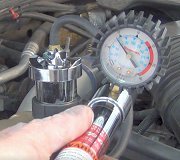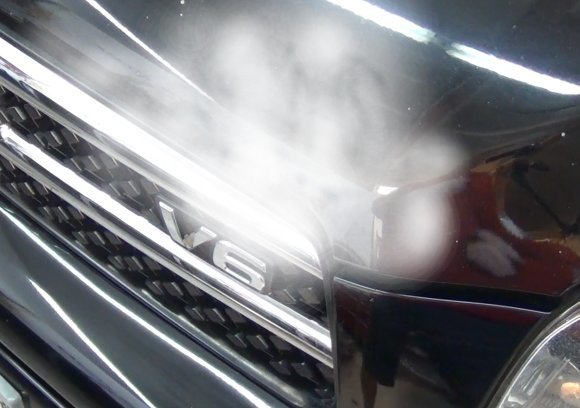You do not have an electrical problem with the fan. It runs when you unplug the coolant temperature sensor. It can only do that when everything is working. This is the equivalent of saying, "my car runs great up to ninety mph, but I am still going to check to see if the tires are flat". We need to be looking at things other than the fan circuit.
You hit on a problem many people do not understand, but for a different reason. Testing must be done when the problem is occurring, as you said, but too many people think that applies to diagnostic fault codes and the check engine light. In fact, once that light turns on, the fault codes are in memory, even if the light goes off later. These codes tell you what problem was detected in the past, and that problem could be occurring right now too.
The issue here is the need for the scanner. Diagnostic fault codes can be read by simple, inexpensive code readers, and those only read codes in the engine computer. Some of the more expensive ones will read codes in a few other computers, but never all of them. Some cars as early as the late 1990's had up to forty seven computers. Only the most advanced scanners will access all of them and read fault codes stored in them.
Reading fault codes is only one or two percent of what full scanners do. If you have fault codes read for free at an auto parts store, they're using the more expensive code readers that cost as much as perhaps $100.00. Scanners used in the repair shops cost in the range of $5,000.00 to $8,000.00. Even the popular Snapon scanners only cost $4,000.00, but they rip the shops off by forcing them to buy annual updates for $1,000.00, and no years can be skipped if you want to buy the latest update.
Once you read the fault code(s), you only know which circuit needs further diagnosis, or the unacceptable operating condition. (Be aware fault codes never ever say to replace a part or that one is bad). If there was a problem with your coolant temperature sensor circuit, the typical fault codes could be, "coolant temperature sensor voltage too high" or "coolant temperature sensor voltage too low". On some older, less-advanced cars, you might only get, "coolant temperature sensor voltage out of range", then you have to figure out why. In either case, to do that, you would switch to the live data screen to see the sensor readings that computer is seeing. I have a Chrysler DRB3 scanner for all of my vehicles. That one lists fifty four things for my old 1994 Grand Voyager, just for the engine computer. You would scroll down to find the coolant temperature sensor voltage, then right after that it would list the temperature the computer has interpreted that to be. This is where you would see what the actual temperature is, and if it's anywhere around 195 to 226 degrees, the engine is fine and it is the gauge you have to look at.
If the temperature really is too high, there is another part of the scanner that shows "inputs/outputs" related to that computer. An example of an input is the neutral safety switch, air conditioner power switch, etc. In this case you would look for the "radiator fan relay" which is an output that is run by that computer. If it is listed as "off", the computer does not want to have it running right now. If it is listed as "on", but the fan is not running, that is when there is a problem in that system that we need to look at. Remember though, we are past that point. You made the fan run by unplugging the coolant temperature sensor.
Another part of the scanner I use quite often is the "actuator test mode", (ATM). This allows you to command the computer to do stuff. In this case, I'd select, "engine computer", "ATM", relays and solenoids", then "radiator fan relay". The engine computer responds by cycling that relay on and off about once per second. If I hear or feel that relay clicking on and off, I know that half of the system is working. Obviously, if I see the fan pulsing on and off, I know the entire circuit is okay. This way you can take voltage readings in the circuit without having to wait until the engine gets hot enough to require the fan to run. The engine does not even have to be running. On my van, the engine computer will even detect when the fan relay is missing from its socket or if there is a break in the wiring, so it tests that half of the circuit all the time. I do not have to even think about whether there is a problem there if are no fault code related to that.
If you look on eBay, there are very reasonably-priced "scanners" that will provide the information you need, but the low cost comes with a few drawbacks. I used one of these that cost less than $40.00. It did show the sensor data, but the screen only shows two or three lines of data at once. The professional scanners show up to twelve lines at once. The bigger issue is the rate at which the numbers update. That little cheapy updated the screen once about every three seconds. That is fine when you just want to know a value or see what a reading goes to when you do something, like unplug that sensor. When you are looking for the cause of an engine stumble or hesitation, for example, you might watch the throttle position sensor's readings while you slowly push the accelerator pedal to the floor. The signal might drop out for a tiny fraction of a second, then come right back, just as that stumble occurs. You would miss that with the inexpensive unit. Professional scanners update their readings multiple times per second so you can see those little glitches and dropouts.
The last important function of scanners is a "record" feature that lets you record a few seconds worth of sensor readings. A lot of common sensors on most engines are fed with 5.0 volts, then the acceptable range of signal voltage is from 0.5 to 4.5 volts. The voltage has to go outside that range for a fault to be detected and a fault code to set. But it is when the voltage remains within that acceptable range, but it is wrong, that elusive problems occur. You can have that stumble or hesitation because the sensor reading is 3.2 volts but it should have been 3.5 volts. Regardless, 3.2 volts is an acceptable value, so no defect would be detected, there would be no diagnostic fault code, and there would not be anything to tell you where to start looking. This is where the record feature is used on a test-drive. When the stumble occurs, you push the "record" button on the scanner. A few seconds of sensor data is recorded so it can be played back slowly, later, to see what changed. Because that data passes through the scanner's memory, the recording actually starts a couple of seconds before the button was pressed. It usually takes an experienced engine performance specialist to notice little things that happened during the "event". Many scanners can put this data on graphs too where it is much easier to see that something changed when the problem occurred. The last step then is to determine if a reading changed and the problem occurred because the computer responded to that incorrect data, or that reading changed as a result of the problem occurring. To say that a different way, most sensors feed information to the computer so that computer can decide what to do, but a few other sensors tell the computer what the result was of what it decided to do. Oxygen sensors in the exhaust system are perfect examples of that. The computer looks at other sensor readings to calculate spark timing and fuel metering, then it looks at the oxygen sensor readings to see what the result of those calculations were.
Wednesday, March 7th, 2018 AT 6:13 PM



